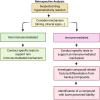Drug hypersensitivity reactions: review of the state of the science for prediction and diagnosis
- PMID: 38588579
- PMCID: PMC11199923
- DOI: 10.1093/toxsci/kfae046
Drug hypersensitivity reactions: review of the state of the science for prediction and diagnosis
Abstract
Drug hypersensitivity reactions (DHRs) are a type of adverse drug reaction that can occur with different classes of drugs and affect multiple organ systems and patient populations. DHRs can be classified as allergic or non-allergic based on the cellular mechanisms involved. Whereas nonallergic reactions rely mainly on the innate immune system, allergic reactions involve the generation of an adaptive immune response. Consequently, drug allergies are DHRs for which an immunological mechanism, with antibody and/or T cell, is demonstrated. Despite decades of research, methods to predict the potential for a new chemical entity to cause DHRs or to correctly attribute DHRs to a specific mechanism and a specific molecule are not well-established. This review will focus on allergic reactions induced by systemically administered low-molecular weight drugs with an emphasis on drug- and patient-specific factors that could influence the development of DHRs. Strategies for predicting and diagnosing DHRs, including potential tools based on the current state of the science, will also be discussed.
Keywords: diagnosis; drug allergy; drug hypersensitivity; prediction.
© The Author(s) 2024. Published by Oxford University Press on behalf of the Society of Toxicology.
Figures



References
-
- Adachi A., Komine M., Tsuda H., Nakajima S., Kabashima K., Ohtsuki M. (2019). Differential expression of alarmins: IL-33 as a candidate marker for early diagnosis of toxic epidermal necrolysis. J. Allergy Clin. Immunol. Pract. 7, 325–327. - PubMed
-
- Adair K., Meng X., Naisbitt D. J. (2021). Drug hapten-specific T-cell activation: Current status and unanswered questions. Proteomics 21, e2000267. - PubMed
-
- Ahmed S. S., Wang X. N., Fielding M., Kerry A., Dickinson I., Munuswamy R., Kimber I., Dickinson A. M. (2016). An in vitro human skin test for assessing sensitization potential. J. Appl. Toxicol. 36, 669–684. - PubMed
-
- Ahmed S. S., Whritenour J., Ahmed M. M., Bibby L., Darby L., Wang X. N., Watson J., Dickinson A. M. (2019). Evaluation of a human in vitro skin test for predicting drug hypersensitivity reactions. Toxicol. Appl. Pharmacol. 369, 39–48. - PubMed
Publication types
MeSH terms
LinkOut - more resources
Full Text Sources
Medical

